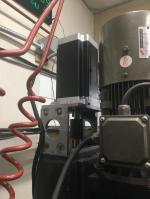I purchased this set to replace the Z axis on my Centroid CNC Bridgeport Milling machine. First of all, the driver works on single phase 220v perfectly. It doesn't need a separate power supply. Secondly, the motor has plenty of torque, I estimate that the 12Nm rating is likely understated, I can get a scary fast 300 ipm from the Z travel (maybe more, I'm not going to push it). Third, since this is a three-phase stepper, it's much quieter than the 4 and 6 wire steppers. It's not silent like an AC Servo, but it is very quiet compared to a traditional stepper.Here's some tips to get it working fast:1) Make sure you understand how to wire for common anode or common cathode for this differential input drive. On my Centroid Acorn I connected the driver's PUL+ ENA+ DIR+ all to a common +24v. Then PUL- DIR- ENA- to each of the outputs on the Acorn. This makes the VCC+ common, and the outputs negative on the Acorn. (make sure your Advanced Settings on the Acorn setup wizard reflects this).2) Yeah it says 1.2 degrees per step on the motor, but the controller doesn't have a 300ppr setting. Forget the 1.2 degree thing, the encoder will determine the step. In this case, that's PA 17 and it needs to be set to 1000 ppr (setting 8).3) UVW - on my motor, U is red, V is black and W is white <<-- the motor will whine and wizzle if you don't have these correct.4) ALARM and PEND are optical outputs from the drive, they can (optionally) be tied to voltage and an input, Alarm is well documented, watch some Marty's garage youtube. PEND has to do with the motor finishing its steps. Since it has an encoder, it will get say, 30000 steps, and it will execute all 30000 of them, but PEND will be active until it completes them. It stands for POSition is PENDing ARRiVal. Sometimes this is called POS and sometimes it's called Arrival, it is optional and eats an input, you probably don't need it, unless you do, then it has it, have fun.5) Make sure your control software knows this is 1000 ppr.


